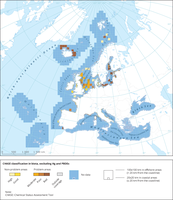
Results of classification of Chemical Status using the CHASE+ tool. Chemical status is evaluated in five classes, where NPAhigh and NPAgood are recognised as ‘non-problem areas’ and PAmoderate, PApoor and PAbad are recognised as ‘problem areas’

Results of classification of Chemical Status using the CHASE+ tool. Chemical status is evaluated in five classes, where NPAhigh and NPAgood are recognised as ‘non-problem areas’ and PAmoderate, PApoor and PAbad are recognised as ‘problem areas’.

Results of classification of Chemical Status using the CHASE+ tool. Chemical status is evaluated in five classes, where NPAhigh and NPAgood are recognised as ‘non-problem areas’ and PAmoderate, PApoor and PAbad are recognised as ‘problem areas’ .

Results of classification of Chemical Status using the CHASE+ tool. Chemical status is evaluated in five classes, where NPAhigh and NPAgood are recognised as ‘non-problem areas’ and PAmoderate, PApoor and PAbad are recognised as ‘problem areas’ .

Results of classification of Chemical Status using the CHASE+ tool. Chemical status is evaluated in five classes, where NPAhigh and NPAgood are recognised as ‘non-problem areas’ and PAmoderate, PApoor and PAbad are recognised as ‘problem areas’ .

Results of classification of Chemical Status using the CHASE+ tool. Chemical status is evaluated in five classes, where NPAhigh and NPAgood are recognised as ‘non-problem areas’ and PAmoderate, PApoor and PAbad are recognised as ‘problem areas’.

The map shows the distribution of fragmentation classes across Europe. Classes represent the number of meshes per 1 000 km2. Light colours mean less fragmentation pressure and dark colours mean higher fragmentation pressure of urban and transport infrastructure expansion.

Article 11 of the Habitats Directive requires Member States to monitor the conservation status of the habitats and species listed in its annexes. Article 17 requires a report to be sent to the European Commission every 6 years following an agreed format. These scoreboards provide information on timeliness of data delivery by Member States for the reporting 2013-2018.

The map shows the oxidised nitrogen concentrations in the upper 10 m of the water column, observed in the years 2013-2017.

The map shows trends per station in chlorophyll concentrations per station in the upper 10 m of the water column, as observed during summer in the years 1990-2017.
Red: significant increase;
Green: significant decrease;
Grey: no significant trend.
Small symbols: ≤10 years of data;
Large symbols: >10 years of data.

The map shows chlorophyll concentrations in the upper 10 m of the water column, observed in the summers of the years 2013-2017.

The map shows trends per station in dissolved inorganic nitrogen (DIN) concentrations in the upper 10 m of the water column, observed in European Seas during winter time during the period 1990-2017.

The map shows trends per station in total nitrogen concentrations in the upper 10 m of the water column, observed during the years 1990-2017.

The map shows the trends per station in orthophosphate (PO4) concentrations in the upper 10 m of the water column, observed during winter of the years 1990-2017.

The map shows trends per station in phosphorus concentrations in the upper 10 m of the water column, observed during winter in the years 1990-2017.